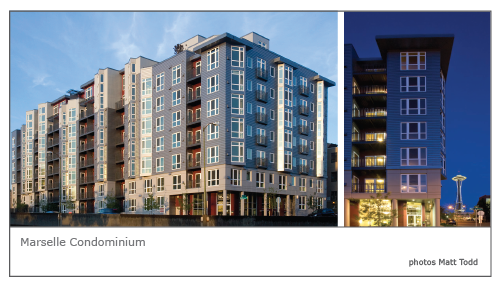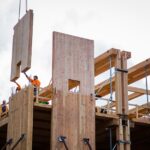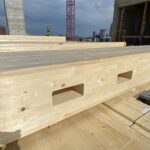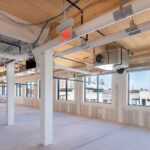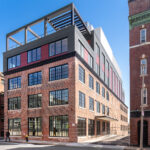Expert Tips
Code Path and Requirements for Podium Projects
Discusses common configurations for podium buildings, including allowable number of podium stories, construction type, horizontal separation, and additional resources.
Podium construction—also known as pedestal or platform construction—typically includes multiple stories of light wood framing over a single- or multi-story podium of another construction style, which may include retail as well as above- or below-grade parking levels. Concrete podiums are the most common, though steel podiums also exist. Although not considered ‘podiums’ under the IBC, using a heavy timber system to separate parking from light-frame wood residential units above is also gaining popularity.
The upper slab of a concrete podium typically acts as both a fire separation and structural transfer slab for the framing above. If built using the special provisions of IBC Section 510.2, this construction approach allows increased density with additional stories, maximizing the use of smaller urban lots while benefitting from wood-frame cost and speed of construction advantages.
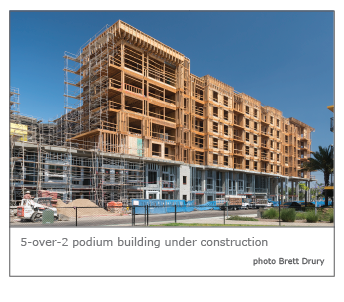
Common configurations include four or five stories of residential use over parking, retail, commercial, and/or office, and six or even seven stories of residential use, including the podium level(s), with subterranean parking.
Multi-story wood construction generally falls under construction Types III and V. Each building type is further subdivided into A and B, which have different fire-resistance rating requirements (A being more rigorous). Type IV construction can also be used for mid-rise structures
A Type III-A wood building is very similar to a Type V-A wood building in practice, with two notable exceptions. Where a designer wants to use wood for exterior walls, it must be fire retardant-treated (FRT) wood, and exterior bearing walls must be 2-hour fire-resistance rated. In multi-family occupancies, a Type III-A or III-B building can include five stories of wood framing while Type V-A can include four stories of wood framing. For additional information on allowable building sizes and opportunities for wood’s use in mid-rise structures, check out this WoodWorks publication.
Podiums are a product of the horizontal building separation provision (IBC Section 510.2). Separated by a 3-hour fire resistance-rated horizontal assembly, these ‘4-over-1’ and ‘5-over-1’ podium-style buildings are treated in the code as two separate structures built one on top of the other for the purpose of determining area limitations, fire wall continuity, allowable number of stories, and construction type.
For the podium to be considered as a separate and distinct building with regard to determining height and area limitations and allowing a break in the vertical continuity of fire walls, it must have an NFPA 13 sprinkler system and be of Type I-A construction. All elevator and stair shafts through the horizontal building separation must be 2-hour rated. Occupancies permitted above the podium include A (occupant load less than 300 if multiple Group A occupancies), B, M, R or S, while all occupancies except H are permitted below the podium. The overall height (in feet) of the two buildings together is measured from grade plane, and is limited by the provisions of Chapter 5 (with increases) for the more restrictive of the two buildings, which in these cases would be the upper Type V or Type III building.
For all IBC code editions up to and including 2012, utilizing the podium or horizontal separation provisions of Section 510.2 requires that the building below the podium be no more than one story above grade plane. The 2015 IBC (and subsequent 2018, 2021, and 2024 editions) expands this opportunity by allowing podiums to include two or more stories below the 3-hour horizontal fire assembly with the caveat that the overall building height above grade (from grade plane to the average of the highest roof plane) must still not exceed the limits set in Chapter 5 for the more restrictive of the two buildings. Most often, it is the maximum allowable height of the construction type (Type V or Type III) that sets the overall building height.
Projects under the jurisdiction of the 2012 IBC (or older editions) have successfully utilized the 2015 (and 2018/2021/2024) provisions to allow a multi-story podium. This typically requires an alternate means and methods request (AMMR) and approval by the Authority Having Jurisdiction (AHJ), but knowing that this allowance is provided in the 2015 edition (and 2018/2021/2024) often takes care of the AHJ’s concern.
WoodWorks can assist designers with the AMMR process—contact your local Regional Director here or the help desk at help@woodworks.org. For additional information on the AMMR process, see this WoodWorks publication. The code change proposal that resulted in the removal of the one-story podium limit in the 2015 IBC is described in change number G133-12, found here. The reasoning included in this proposal has been used to successfully navigate the AMMR process through local building departments for multi-story podium projects under the 2012 or older editions of the IBC.
This presentation by a California based architect, who has done many multi-story podium projects, reviews how the code has evolved over the years to allow these types of buildings: //www.woodworks.org/wp-content/uploads/17NW05-SMITH-Multi-Story-Podiums-WSF-170425.pdf
The first page of this Structure magazine article also includes a summary of some of these code provisions: //www.woodworks.org/wp-content/uploads/5-over-2-Podium-Design-WoodWorks-Part-1-Path-to-Code-Acceptance.pdf
This WoodWorks case study features 1430 Q in Sacramento, CA, which successfully utilized a multi-story podium in 2020.
